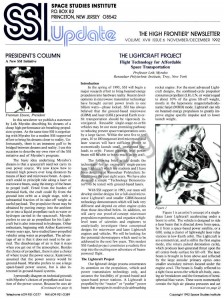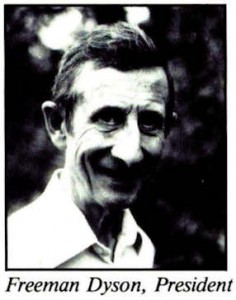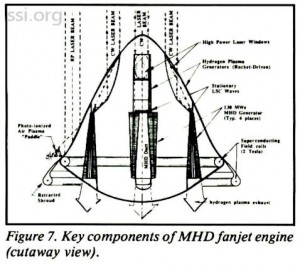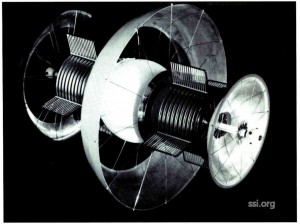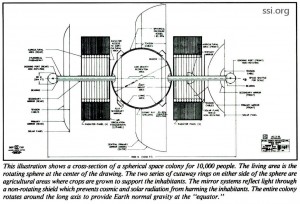SPACE STUDIES INSTITUTE
P.O BOX 82
PRINCETON, NEW JERSEY 08542
[[librarian note: This address is here, as it was in the original printed newsletter, for historical reasons. It is no longer the physical address of SSI. For contributions, please see this page]]
SSI UPDATE
THE HIGH FRONTIER® NEWSLETTER
VOLUME XVIII ISSUE 6 NOVEMBER/DECEMBER 1992
PRESIDENT’S COLUMN
A New SSI Initiative
In this newsletter we publish a statement by Leik Myrabo describing his dreams of a cheap high-performance air-breathing propulsion system. At the same time SSI is negotiating with Myrabo for a modest SSI-supported effort to bring his dreams closer to reality. Unfortunately, there is an immense gulf to be bridged between dreams and reality. I use this occasion to describe my own view of the SSI initiative and of Myrabo’s program.
The basic idea underlying Myrabo’s dreams is that a spacecraft need not carry its own power source. We now know how to transmit high powers over long distances by means of laser and microwave beam. A spacecraft could in principle ride along a laser or microwave beam, using the energy of the beam to propel itself. Freed from the burden of chemical fuels, the craft could fly from the ground into orbit as a single stage, with a substantial fraction of its take-off weight as useful payload. The propulsive thrust may be obtained by putting energy into the ambient air or into a liquid propellant such as water or hydrogen carried in the spacecraft. Myrabo prefers to use air as propellant for his Lightcraft but is also interested in hydrogen. Other enthusiasts, beginning with Arthur Kantrowitz twenty years ago, have studied laser-propelled vehicles using water as propellant. The advantage of air is that it does not need to be carried. The disadvantage of air is that it stops when you get out of the atmosphere. Besides the choice of propellant, there is also a choice of where to put the power source. Kantrowitz assumed that the power source would be ground-based. Myrabo prefers to use a large space-based power source, but is also interested in ground-based systems.
I personally disagree on technical grounds with Myrabo’s choices of propellant and location of the power source. Because he uses air as propellant, his engine must change its mode of operation through several separate regimes as the Mach number changes from take-off to orbit. An engine with as many as five different configurations is unlikely to be either cheap or trouble-free. Likewise, the use of a satellite power source introduces many technical difficulties, quite apart from the fact that satellite power sources do not yet exist. A water-driven propulsion system and a mountain-top power source seem to me simpler and more likely to be cost effective. However, these personal disagreements should not stand in the way of fruitful collaboration between SSI and Myrabo. Myrabo is looking at simpler versions of his engine in which fewer than five configurations are used, all the way down to a single-configuration engine. Every possible power beam propulsion system, ground-based or spacebased, air or water or hydrogen, laser or microwave, needs to be explored. Myrabo cannot explore the whole universe of power beam propulsion systems by himself. Myrabo should explore the system that he prefers, and we may hope that his work will stimulate others to explore other possibilities.
Nobody has yet built a model laser-driven or microwave-driven engine that produces enough thrust to lift itself off the ground. This is the essential first step that must be taken before any detailed design of full scale systems will make sense. We hope that, with the modest level of support that SSI may provide, Myrabo might be able to build a model engine that will give some reality to his dreams and to ours.
In my opinion, this modest jump into the development of a radically new space propulsion system is exactly the sort of thing that SSI ought to be doing. I consider Myrabo the bestqualified person to do the necessary technical work. He has the three essential qualifications, technical competence, unconventional ideas, and irrepressible determination. SSI would like to see a model beam-power engine built and its performance demonstrated, in the same style as the model mass-driver that we built and demonstrated ten years ago. The mass-driver is a technical success, but we have to get to the Moon first before we can put it to work. If the theoretical advantages of a power beam engine can be translated into real hardware, we may succeed in persuading the world that the idea of cheap travel to the Moon is not crazy.
THE LIGHTCRAFT PROJECT
Flight Technology for Affordable Space Transportation
Professor Leik Myrabo
Rensselaer Polytechnic Institute, Troy, New York
Introduction
In the spring of 1993, SSI will begin a major research effort to bring beamed energy propulsion into hardware reality. Recent developments in microwave transmitter technology have brought current power levels to one billion watts-phase locked. SSI has always believed that the ground-based microwave (GBM) and laser (GBL) powered Earth to orbit transportation should be vigorously investigated. Reusable single-stage-to-orbit vehicles may be our most promising pathway to reducing present space transportation costs by a large factor. Within the next five to ten years, 10 to 100 megawatt level microwave and laser sources will have sufficient power to economically launch small, unmanned payloads to orbit. Future gigawatt level power beam will be able to boost much larger craft.
The following brief article details the technology for an exemplary single-person laser Lightcraft which my students and I have been designing at Rensselaer Polytechnic Institute over the past eight years. We have also designed a simple “Technology Demonstrator” to be tested with ground-based lasers.
With SSI support in 1993, our team will develop similar designs for a full-sized microwave Lightcraft and smaller GBM-boosted technology demonstrators which will look very different and depend on other engine cycles than those described below. In addition, we will carry out proof-of-concept microwave propulsion experiments, and organize a highlevel team of scientists and engineers to analytically investigate these conceptual designs for microwave and laser Lightcraft engines and vehicles. We will be looking for the potential showstoppers which need to be addressed in the next few years. This modest SSI-funded project constitutes a realistic first step into the exciting new adventure of beampowered flight.
The Lightcraft Project
Our lightcraft design process concentrates its attention on the propulsion, vehicle and power transmission technology only, and assumes the feasibility of ground-based and space-based power stations. A Lightcraft is propelled by the “tractor” or “pusher” power beam that energizes its multi-cycle airbreathing rocket engine. For the most advanced Lightcraft designs, the combined-cycle propulsor consumes propellant (LH2 LN2 or water) equal to about 10% of the gross lift-off weight, mostly in the hypersonic magnetohydrodynamic fanjet (MHD) mode. Lightcraft can rely on beamed energy propulsion to greatly improve engine specific impulse and to lower launch weight.
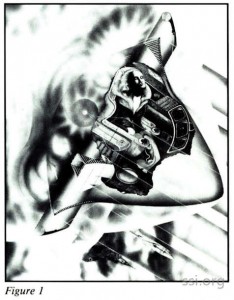
Figure 1 is an artist’s concept of a singleplace Laser Lightcraft accelerating under a boost to orbit. The vehicle is designed to ride a laser beam that is directed down from space, be it from a space-based power satellite, or a GBL using a cluster of lightweight laser relay stations in low-Earth orbit. The Lightcraft is axisymmetrical, and is still in the first engine mode, (the rotary pulsed detonation cycle), which produces laser-generated thrust upon the aft center-body surface for lift-off. The laser beam is brought in from above and reflected by the large annular primary optics onto smaller secondary mirrors located under the engine cowl. The beam is finally reflected to a tight focus across the vehicle aft-body, causing air breakdown and the formation of hemispherical blast waves. These waves momentarily contain the high air plasma pressures and act to produce thrust, as shown in Figure 2. Figure 3 gives the overall dimensions of the Lightcraft, with the shroud shown in the nominal position.
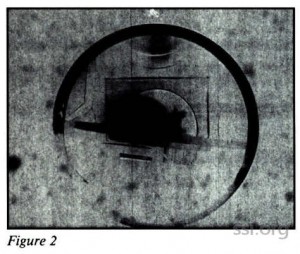
A tripodic landing gear is necessary for precisely pointing at, and for tracking the low altitude power satellite just prior to lift-off. The entire vehicle kneels for the occupant to enter through the hatch.
The primary optics occupy about half of the vehicle’s upper surface. The primary optic is designed to receive pulsed laser beams at only twenty-four specific mirror locations. Each cylindrical beam will have somewhat uniform intensity distribution. Three detectors per beam monitor the laser intensity at the beam’s edge. These detectors are linked to an active feedback system to provide accurate beam pointing and tracking information.
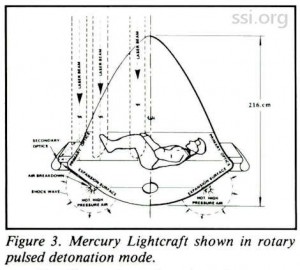
Significant phase distortions due to aerooptical phenomena will be produced in each power beam as it transverses the bow shock wave. These effects are dominant mostly in the lower supersonic flight regime. As a result, the primary mirror must be an adaptive surface that is actively controlled throughout the acceleration run (see Figure 4). Since the phase distortions are a direct function of flight Mach number and the aerodynamic pressure across the fore-body, they can be sensed, as well as corrected, at the vehicle flight platform. Adaptive mirror technology is advancing at a rapid rate under several aggressive programs, and reflectivities have already reached 99.99%.
During the rotary detonation mode, used for hover and acceleration through Mach 1, each of the 24 secondary mirrors focuses the reflected laser beam into a two-centimeter diameter region, a “plasma finger,” parallel to the vehicle’s lower surface. This laser energy is transferred directly into the air by inverse Bremsstrahlung absorption and creates a high pressure explosion. The firing sequence can either detonate all 24 of the plasma fingers simultaneously, or in a predetermined pattern for thrust vector control. Additional plasma fmgers can be inserted between the fundamental 24 sites, which are tied directly to the number of primary mirrors, by using adaptive optics.
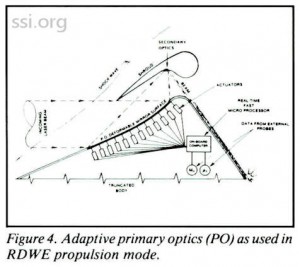
Note in Figure 2 that the rotary detonation wave mode automatically compresses air into adjacent plasma finger sites, just before the next detonation. This inherent supercharging function can provide high liftoff thrust levels at zero forward velocity.
In hypersonic flight, the MHD fanjet, a unique electric engine mode is used. Beyond Mach 11 and 90 thousand feet in altitude, the shroud is translated to full aft position, and flight propulsion is transferred to the MHD fanjet mode. Here a laser heated, rocket driven magnetohydrodynainic generator (see Figure 5) supplies sufficient electric power to accelerate the air plasma slipstream captured behind the bow shock (see Figure 6). It is designed to run on liquid hydrogen, but water remains an unexplored possibility.
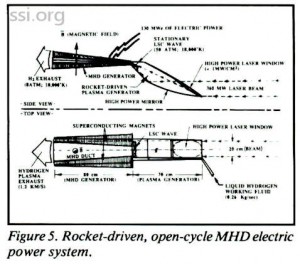
Each of the four laser-to-electric MHD power converters supply 130 MWe to onequarter of the shroud airflow. The two ringshaped superconducting magnets conduct a current of one mega-amp each to generate a two Tesla magnetic field over the shroud upper surface-needed by the annular MHD air accelerator.
To product sufficient levels of electrical conductivity in the airflow at the entrance of the MHD accelerator, pulsed laser power beams upon the primary optics are again used to ionize “fans” sequenced at appropriate time intervals. These fans are then accelerated off the shroud, producing thrust, and, in the process, greatly reducing the strength of the bow shock wave. With enough power, the bow shock may be completely dissipated (as indicated in Figure 6). Mach 25 is finally reached at 180 thousand feet in altitude when the rocket mode is energized for orbit circularization.
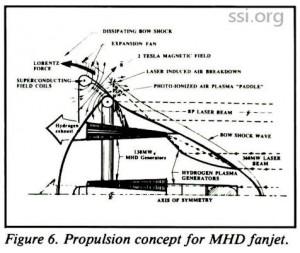
Critical proof of concept laser propulsion experiments were carried out in February 1991 on the laser-Lightcraft’s pulsed detonation liftoff engine. This full scale engine segment performed as well as the first experimental kerosene-powered turbojet engines, (180-200 newtons of thrust per megawatt of input thermal power). Given this efficiency, a single 35 MW laser power beam, rapidly pulsed and rotating, could hover the 700 Kg single-person Lightcraft, whereas three active beams in tripodlift configuration will accelerate it at three g’s. With further development, beam power levels may be cut by a factor of five. Other full scale engine segment experiments on scramjet and MHD fanjet modes are being readied for RPI’s hypersonic shock tunnel (Mach 10-25) – linked to a one-gigawatt pulsed CO2 laser (1KJ, luscc) on loan from the Naval Research Laboratory.
Reliable, low-cost space transportation is of fundamental importance to SSI – since without it we will never have tens of thousands of people living and working in space within our lifetimes. The long-term goal of powering an efficient global hypersonic transportation system that can replace bulky chemical fueled launch systems with clean space power is one revolution that everyone should welcome. Direct flights into low Earth orbit and to the “Moon are easily within the reach of such hyper-energetic Lightcraft – which can be specifically designed and engineered for those missions.
SSI’s new project on the beamed energy propelled spacecraft is being carefully orchestrated to capitalize on the recent rapid developments in ground-based high power microwave and millimeter wave power beaming technology – as well as to lay the foundations for exploiting high power laser sources, once they appear ready. We are now assembling a high level team of U.S. and Russian scientists and engineers to explore new launch system opportunities.
This initial modest program will concentrate on proof of concept laser and microwave propulsion experiments and parallel analytical investigations -carried out in concert to promote understanding of the basic underlying principles. The experiments will be performed on available high power lasers and microwave sources located at RPI, the Naval Research Laboratory, and elsewhere. Test plans for multiple proof of concept experments will be developed, the number depending upon what SSI resources become available. The goal is to carry out at least two air-breathing beamedenergy propulsion tests, one with a high power laser, the other with a powerful pulsed microwave source. We will perform both at sea level ambient conditions, using existing and easily upgraded (mostly RPI) experimental apparatus.
Efforts are underway to secure laser and microwave lab testing time – free of charge to SSI or RPI – to minimize costs and maximize the use of available funds. Key performance parameters to be measured in these propulsion experiments will be time-varying pressures, temperatures, air-plasma and shock wave velocities, in addition to the input beam pulse energy, delivered impulse, and coupling coefficient (the ratio of impulse to beam energy).
I have assembled numerous analytical models for predicting the performance of beamed energy, combined-cycle engines over the past six years. We will refine the input assumptions, and analytical methodologies, as necessary to match current engine test parameters. Then these computational models will be exercised to predict the engine performance data anticipated from the experiments. A number of other analytical models will be assembled as required.
An essential ingredient in developing revolutionary new concepts for hyperenergetic spacecraft is to exploit the superior properties of today’s advanced carbon fiber and Kevlar composite structures technology. These axially symmetric, advanced aerospace tensile structures can perhaps be fabricated using filament winding techniques which have already reached maturity in the aerospace industry.
We will carry out spacecraft design studies for representative laser-boosted and microwaveboosted Lightcraft, with the aid of Burt Rutan and Brandt Goldsworthy. For this challenging spacecraft design effort, the primary composite structure must accommodate the requirements of all essential engine subsystems.
In support of these studies, we are requesting Raytheon engineers to provide specifications for suitable microwave antennae designs and other details such as the transmissive properties of composite structure aeroshells and high power microwave windows.
Final output will include detailed conceptual designs for microwave-boosted technology demonstrators and full sized manned vehicles.
Until now, SSI’s plans have been like constructing a battleship in a bottle. We have tried to show how great things can be done with only a small mass launched from Earth. The bottleneck is the high cost of access to space. This is a plan to break the neck off the bottle and build a highway to space.
At the time of his death, Dr. O’Neill was working actively on alternatives to chemical rockets. Because, although not now for sale, the price of a ticket to orbit is on the order of $1,000,000. Professor Myrabo details a plan to knock two or three zeros off that depressing figure.
Over the next year SSI plans to test both microwave and laser powered light craft engine segments. This resumes SSI’s tradition of performing hardware research on long lead time, high payoff projects.
BERNAL SPHERE MODEL ARRIVES
SSI contracted a Russian firm to build a scale model of the bernal sphere. In late October the model was brought to the United States courtesy of Martin Marietta aboard their corporate plane, for which we are very grateful.
The model was constructed from aluminum and various alloys. It is approximately 24″ in length and stands 24″ high. It has a custom shipping crate which will enable us to safely ship it to conferences and media events around the country.
The model builder has agreed to make additional models, painted to the buyer’s specifications, for $1,000.00 each, FOB Moscow. We are working with several museums at this time and expect to place several models in permanent exhibit this year. If you are interested in purchasing a model, please contact Space Studies Institute.
Professional pictures and slides have been taken of the model to which special effects will be added to show the colony in space and with other objects to show perspective. As these new pictures are available, we will include them in upcoming issues of Update.
Having an audience visualize space structures has always been a problem when making presentations or dealing with the media; we are pleased to have this model available to help deliver our message.
We would like to thank our Russian friends, Martin Marietta, and Chris Faranetta for their help in obtaining this model.
ABOUT THE INSTITUTE
The Space Studies Institute is a nonprofit, international, research and educational organization. Founded in 1977, it is dedicated to opening the high frontier of space.
SSI’s goals include using the material wealth and solar energy of space to improve the human condition both for those who live on Earth and those who live in space, and building Earth-like habitats in space to expand the ecological range of humanity throughout the solar system and ultimately, perhaps, throughout the galaxy.
To this end, SSI has conducted and is conducting pioneering research into advanced space propulsion, the extraction and processing of nonterrestrial materials for engineering purposes, and the identification and location of lunar and asteroidal resources.
SSI is a board member of the International Space University. The Senior Associates and Members of SSI provide the critical financial support that makes possible its continuing research and educational programs.
Please photocopy your copy of the SSI Update and donate copies to your library, school and friends. This helps SSI spread the word.
To inquire about the Senior Associates and Member programs, please call xxx-xxx-xxxx.
SPACE BUSINESS ARCHIVE
The Space Business Archive is thrilled to announce that it’s most recent contributions include handwritten letters from space pioneer Dr. Werhner von Braun. One five-page letter discusses “The American Star,” a rocket wrapped in reflective material that could be seen in the morning and during twilight hours. The idea, believed Dr. von Braun, was to convince Congress and the American public of the value of the still unborn space program.
“We have not searched for early documents” explained Archive director Mr. Jeffrey Manber, “but when given the opportunity we will certainly accept historic documents and treat them well so that future historians can understand and write about the birth of our American space program.”
Space Studies Institute will place these documents in special archival folders to prevent further deterioration. Copies have been carefully made so that all researchers can enjoy access to this wonderful addition to the Archive.
Anyone wishing to donate materials to either the Space Business Archive or the Gerard K. O’Neill Library should contact the SSI office for details and procedures prior to sending any materials to SSI.
THE HIGH FRONTIER CONFERENCE XI:
Bringing the Vision of Space Into Reality
May 12-15, 1993
Call for Papers
The Space Studies Institute is soliciting papers that substantially detail recent and current work on any topic relevant to the field of space development, and space exploration.
Anyone wishing to submit an abstract for the upcoming conference is asked to do so by January 11, 1993.
For a copy of the complete Call for Papers, please call SSI at xxx-xxx-xxxx during business hours, or leave a message on the SSI voice mail system xxx-xxx-xxxx, 24 hours a day.
©space studies institute
NEXT: 1993 January-February (Senior Advisor George Gallop, Jr. polls the SSI membership)

